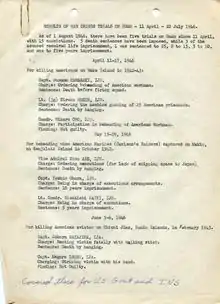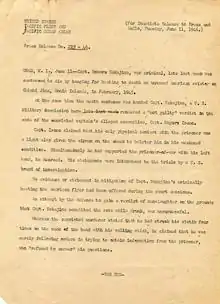Chichijima incident
The Chichijima incident (also known as the Ogasawara incident) occurred in late 1944, when Japanese soldiers killed and consumed five American airmen on Chichi Jima, in the Bonin Islands.


Incident
Nine airmen escaped from their planes after being shot down during bombing raids on Chichi Jima, a tiny island 700 miles (1,100 km) south of Tokyo, in September 1944. Eight were captured. The ninth, the only one to evade capture, was future US President George H. W. Bush, then a 20-year-old pilot.[1]
After the war, it was discovered that the captured airmen had been beaten and tortured before being executed. The airmen were beheaded on the orders of Lt Gen. Yoshio Tachibana (立花芳夫, Tachibana Yoshio). American authorities reported that Japanese officers then ate parts of the bodies of four of the men.
Trials
Tachibana, alongside 11 other Japanese personnel, was tried in August 1946 in relation to the execution of U.S. Navy airmen, and the cannibalism of at least one of them, during August 1944. Because military and international law did not specifically deal with cannibalism, they were tried for murder and "prevention of honorable burial".
This case was investigated in 1947 in a war crimes trial, and of 30 Japanese soldiers prosecuted, four officers (General Tachibana,[2][3] Maj Matoba and Captain Yoshii) were found guilty and hanged. All enlisted men and Probationary Medical Officer Tadashi Teraki were released within 8 years.[4]
Lieutenant General Mori was initially sentenced to life imprisonment in this trial. However, after his subordinates were convicted of slaughtering prisoners during their time on the Southern Front, he was sentenced to death in a separate war crimes trial organized by the Netherlands. Furious, the Dutch authorities executed them with Lewis light machine guns.
Book
In the best-selling book Flyboys: A True Story of Courage, American author James Bradley details several instances of cannibalism of World War II Allied prisoners by their Japanese captors.[5] Bradley claims that this included not only ritual cannibalization of the livers of freshly killed prisoners, but also the cannibalization-for-sustenance of living prisoners over the course of several days, amputating limbs only as needed to keep the meat fresh.[6]
See also
References
- Laurence, Charles (October 26, 2003). "George Bush's comrades eaten by their Japanese PoW guards". The Telegraph. Retrieved November 15, 2014.
- Case No. 21 Trial Of General Tomoyuki Yamashita[,] United States Military Commission, Manila, (8 October–7 December 1945), and the Supreme Court Of The United States (Judgments Delivered On 4 February 1946). Part VI. Archived from the original on December 8, 2006. Retrieved December 18, 2006.
- Welch, Jeanie M. (April 2002). "Without a Hangman, Without a Rope: Navy War Crimes Trials After World War II" (PDF). International Journal of Naval History. 1 (1): 5–6.
- Welch, JM (April 2002). "Without a Hangman, Without a Rope: Navy War Crimes Trials After World War II" (PDF). International Journal of Naval History. 1 (1). §Cannibalism. Retrieved December 3, 2007.
- Bradley, James (2003). Flyboys: A True Story of Courage (1st ed.). Little, Brown and Company. ISBN 0-316-10584-8.
- Bradley, James (2004) [2003]. Flyboys: A True Story of Courage (1st ed.). Boston: Back Bay Books. pp. 229–230, 311, 404. ISBN 0-316-15943-3. Retrieved December 26, 2007.